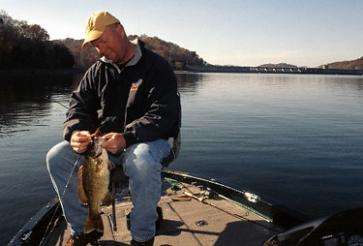
As a lifelong angler in the heart of smallmouth bass country, I’ve had the privilege of introducing lots and lots of largemouth anglers to brown bass fishing. Some of them have been really good fishermen, but most of them have had a lot of trouble getting the hang of smallmouth fishing. Far and away the biggest struggle they’ve had has been in setting the hook.
Hundreds of magazine articles and many television and video segments have been written and made about how to set the hook when bass fishing. The problem is that none of them that I’ve ever read or seen really covered smallmouth hook sets. Just as smallmouths are different than largemouths, the proper way to set the hook on a brown bass is generally different from the best way to set the hook on a green fish.
I love to go jig fishing at night in the summertime for big smallmouth, and when I take a largemouth fisherman with me, I’ll just about bet that he misses most of his first few strikes because he doesn’t get a good hook set.
Oh, he’ll set the hook plenty hard. I’ve seen some of them nearly fall out of the boat backward when they rear back on a fish. And their equipment is usually just fine for the task, too. The problem is that they’re not thinking about what they’re doing, and they’re not moving line the right way on the set. Here’s what happens.
Most of my summertime jig strikes come in 20 to 30 feet of water. That means I’m more above the fish than I am horizontally distant from them. When I set the hook, I come up with the rod — hard! A lot of largemouth fishermen, because they’re used to fishing shallow water for their green fish, sweep set the hook to their side. This doesn’t move the line in the right direction to get good hook penetration. It moves plenty of line, but not in the right direction, so they miss a lot of fish.
That sweep-set is great if you’re fishing mostly horizontally. But if you’re more vertical than horizontal — and you will be on deep, clear impoundments — you need to come up with the rod tip.
Another thing largemouth fishermen do — or fail to do — that costs them fish is they don’t get on the reel as they’re setting the hook. A successful smallmouth fisherman is cranking on the handle of that reel during the actual hook set. He doesn’t wait until the set is over. There are a couple of reasons for this.
First of all, by cranking as you set, you’ll move more line and get better hook penetration. Second, since smallmouths tend to move toward deep water when hooked (while most largemouths will move toward cover), you’ll compensate for the fact that the smallmouth is moving toward you as you set the hook. This will really help your hook-up percentages. Try it!
Finally, don’t get into a feeling contest with smallmouth bass. As soon as you feel the bite — or just feel something different — set the hook … now! Don’t wait until you’re sure he’s there or wait to get in the perfect hook setting position. Set the hook fast and get the reel cranking. You’ll have a much better chance of putting that fish in the boat by being quick on the set and getting the line moving right away.
Until next time, if you have any questions or comments, I’d love to hear from you. Please e-mail me atStephen@thesmallmouthguru.com.





